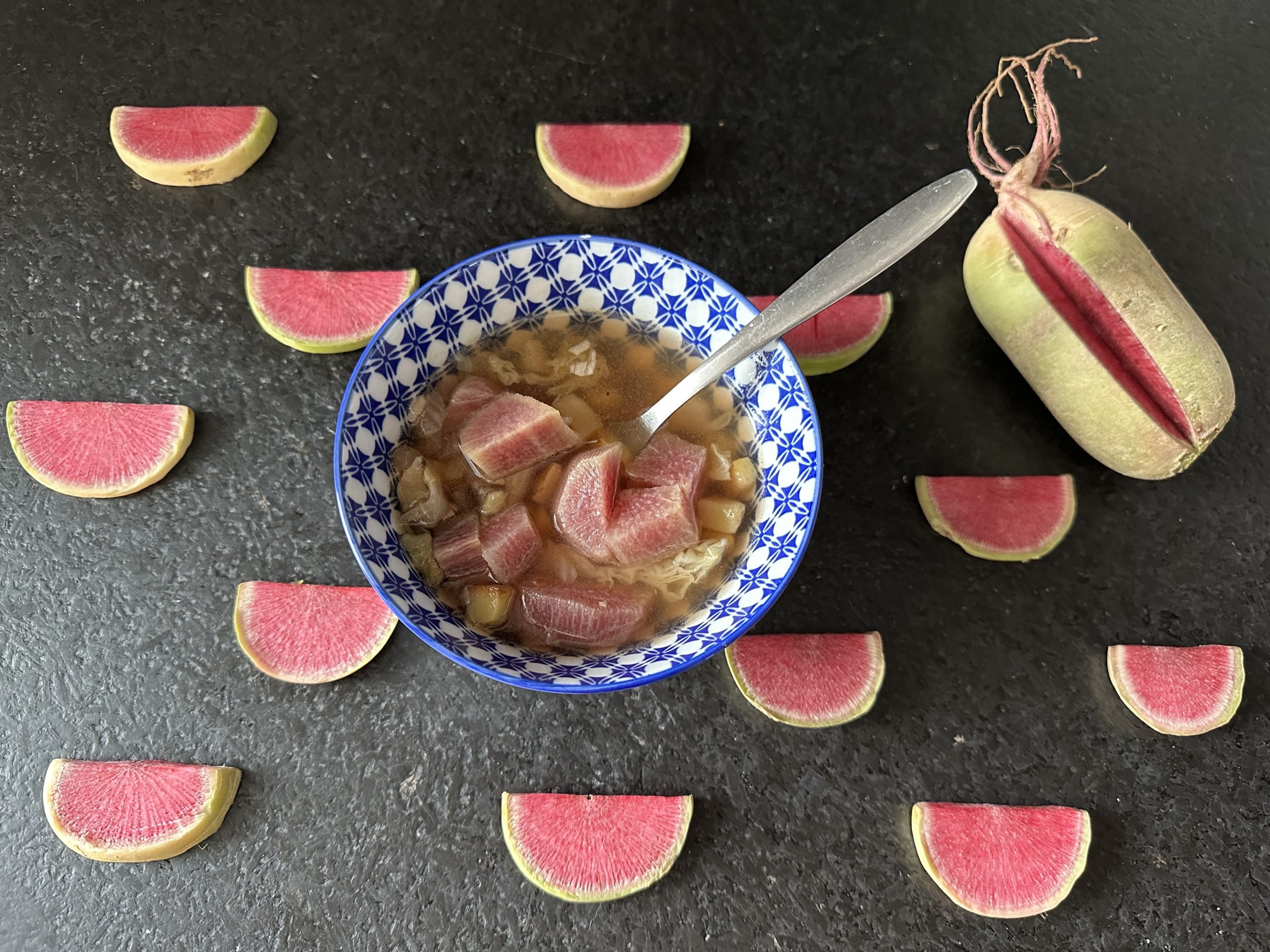 Word File: Watermelon Radish Soup
Word File: Watermelon Radish Soup
Winter Watermelon Radish Soup
Relish the Radish
At the final farmers market of the summer I was buying winter melons from a farmer named Nancy. She’s from Northern China, and often sells produce I’ve never heard of. After I filled my bag with those obscure winter melons, which taste sweetly like muskmelon, Nancy pivoted smoothly into giving me the hard sell on a tuber the size and shape of a russet potato. She had one left. It had grown so quickly that its pale green skin was split open, revealing red pink flesh inside. This root crop was another melon of sorts, an heirloom radish known as watermelon radish.
“Very good for soup,” she assured me in her thick, endearing accent. “So good with pork,” she added wistfully, speaking my language fluently.
Also known as a Chinese Red Meat Radish, and sometimes called the “beauty heart radish,” the watermelon radish is an heirloom variety of daikon. It can keep for months if stored properly, making it a favorite among winter market farmers. I’ve noticed it at specialty grocery stores too, since Nancy put it on my radar. While the skin is spicy and a slightly bitter, the flesh is mild, whether it’s raw or cooked.
I didn’t learn many of those watermelon radish facts from Nancy though. In fact, I had somehow managed to walk away from her stand thinking that I had just bought a red-fleshed turnip.
This misidentification wasn’t an issue at first, because I followed her directions and made a glorious batch of brothy soup. But I use the term “directions” in a very loose sense, because Nancy is not a micro-manager when she gives a recipe. So the recipe is partly my own.
“Cook the pork,” she had said. “Then chop chop chop the onions so very small.” After that, she directed, add ginger, salt, pepper and vinegar.
I started with bacon, and then added potatoes and cabbage, because I have a hard time not messing with recipes. But these low-key additions did not disrupt the subtle nature of the soup, I promise. The radish flesh turned soft, watery and sweet, and the resulting soup was mellow and satisfying. Other than the ginger and rice vinegar there were no Asian ingredients, but the subtle flavor had an exotic vibe. Nobody could stop eating it — even my son the picky eater who can be suspicious of vegetables.
“I can’t believe how much good food you’re eating,” I commented.
“Well,” he explained, “this good food is really good.”
A few days later I went looking for red-fleshed turnips at the supermarket, because that is what I thought I’d bought from Nancy. I couldn’t find any, of course — because they don’t exist. I brought home some regular white turnips instead, and the resulting soup was not the same. It was harsh, thanks to the spicy turnip. I added kale, carrots and chunks of baked squash, and seasoned with soy sauce and fish sauce. I added meat and green tomatoes, my new favorite fall ingredient. The flavor improved with each addition, and I ended up with a complex and satisfying cold weather stew. So if you find yourself with some turnips you don’t know what to do with, this dish is a great option. But it’s nothing like the mild, comforting, otherworldly flavor of radish broth.
I’ve previously written about a Korean chilled daikon radish soup called Naengmyeon. That soup is a show-stopper as well. Since daikon is a close relative of watermelon radish, I gave Nancy’s recipe a shot with daikon. The flavor was equally mesmerizing.
If you happen to be lucky enough to find watermelon radish, run home and make this soup. Otherwise daikon is available everywhere. It’s not quite as pretty or sweet, but you nonetheless have no excuse to not make this soup.
Here is Nancy’s recipe as best I understood it, plus my added potatoes and cabbage, which you can omit if you want to stay true to her version. I’ve made her soup with beef instead of pork as well. It’s good, but slightly thinner without the irreplaceable glaze of pig fat. Of course, if you’re not a pork eater you wouldn’t miss it.
Whatever tweaks you make, don’t overdo it like you’re trying to out-wrestle a turnip. With radish soup, less is more.
Watermelon Radish Soup
If you can find watermelon radish at a specialty vegetable stores or your local winter market, grab it. If not, don’t hesitate to use daikon.
I wish I could advise you to cook it with the peel on, because that really does make it resemble a watermelon. But the peel makes the flavor too spicy and bitter, which breaks the spell.
Serves 4
½ pound pork or red meat, cut into ½-inch chunks (optional)
2 tablespoons olive oil
1 pound potatoes, cut into ½-inch dice
1 onion, chopped small
1 cubic inch of peeled ginger, grated
1 clove of garlic, minced
8 cups water (or vegetable stock if you’re not using meat)
1 cup shredded or finely chopped cabbage
A pinch of black pepper
2 teaspoons salt
2 teaspoons rice vinegar
6 ounces of peeled watermelon or daikon radish flesh, with stem and root ends removed and peeled, cut in ¾ inch dice
Start with the meat and olive oil at the bottom of a heavy-bottom soup pot on medium heat. After five minutes add the potatoes. Five minutes later, add the onions and cook with the lid on for ten minutes until they are translucent. Add the ginger and garlic and cook briefly until the garlic smells fragrant. Add the water, cabbage, salt, pepper, vinegar and radish. Simmer on medium heat until the radish is soft but not soggy, about 15 minutes.